A Capella is an iconic 37-year-old trimaran that has been abandoned and rebuilt three times, but will line up for the start of this year’s Route du Rhum solo transatlantic race
They say a cat has nine lives, A Capella is a trimaran which seems to have twice as many, writes Andi Robertson.
Next year the Route du Rhum, the storied French solo race from St Malo to Guadeloupe in the Caribbean, celebrates its 40th anniversary.
Part of the magic of this November 2018 edition will be a widely anticipated friendly showdown between three Walter Greene 12m (36ft) trimarans. The trio are near-sisterships to the tiny Olympus Photo that won the first ever Route du Rhum in 1978.
When skipper Mike Birch and the seemingly diminutive trimaran stole victory on the finish line by 98 seconds from under the nose of Michael Malinovski’s much fancied 21m monohull Kriter V, after 23 days of racing, it ensured the Route du Rhum would be forever synonymous with multihulls.
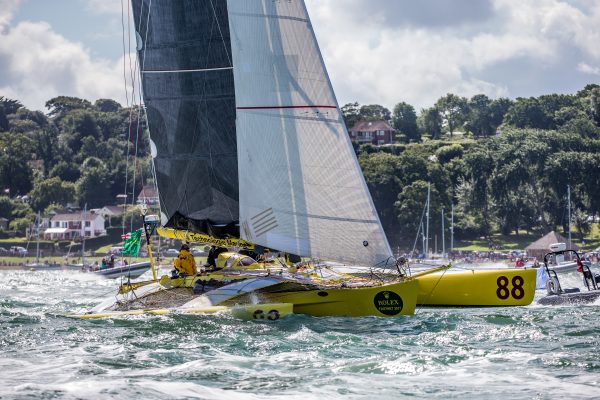
Acapella starting the 2017 Rolex Fastnet Race ©Sportography
The 2018 race will be the sixth Rhum for Charlie Capelle’s faithful A Capella. A Capella (the name virtually homonymic with his surname Capelle, entirely coincidentally) is a remarkable trimaran which has refused to die, thanks to her faithful, deeply smitten owner.
Capelle’s personal association with the five-boat series of Acapella trimarans goes back to 1978 and Even Keel Road in Yarmouth, Maine, where Capelle learnt his craft boat building at the designer and builder Walter Greene’s yard. He has since worked on projects including Banque Populaire and Sodebo.
This particular A Capella was originally built for American sailor Spencer Merz as the third in the series after Birch’s Olympus, which was subsequently lost, and the second boat, Phil Steggall’s Friends and Lovers. In order to fund the boat, Merz chartered it to Philippe Poupon for the 1981 TwoSTAR race between Plymouth and Newport. Poupon went to Maine to see her, meeting up with Capelle then.
Capelle smiles at the still vivid memory, “Philou [Poupon] asked me to sail the boat back to Europe with him. Once back, Philou said ‘You might as well do the race with me.’ It was then I discovered a magical boat. Extraordinary. Intelligent. When I came back here, I set up my own yard.”
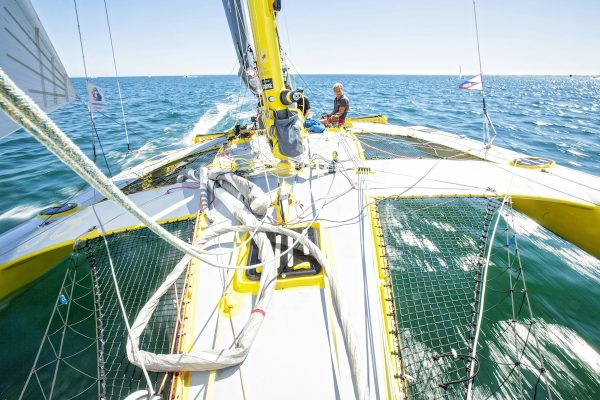
Acapella (the sister ship of Mike Birch famous Olympus) built by Walter Green in 1980 and skippered by Charlie Capelle, is preparing to take part in “La Route du Rhum” 2018 ©Christophe Launay

The automatic capsize system (ACS) is very simple. A pin keeps the sheets in two large Harken cam cleats. If the system detects a capsize then the pin is removed. It requires a certain amount of seamanship to set up the system and ensure that there are not too many wraps around the winch which the sheet needs to be released from. Or, if the sheets have been in place for some time, to make sure that salt has not encrusted them to such an extent that even when the system wants to release they stay stuck on the winch. As A Capella is smaller than IDEC, on which the system was developed, the movement of the yacht is such that the ACS can think a capsize is imminent when in fact it is not. Hence Capelle uses a ‘manual’ variant of the system, which works in the same way, except he has a button on a piece of string around his neck which fires the pin. ©Christophe Launay

Interior comforts are limited but stylish, with a custom-made chair, and original wooden fittings
The Acapella trimarans were designed and built as if to prove their strength, speed and longevity. Capelle recalls: “Walter Greene taught me how to build boats using moulded wood and epoxy with floats made of composites. There was a classic aluminium rig.
“What was interesting about these boats was that they were built with economy in mind in terms of the construction and fittings. They started to attract people. Mike won the 1978 Route du Rhum, proving that it was possible for a 38ft trimaran to cross the Atlantic and win races. All of today’s designers were impressed and influenced by the Acapella trimarans. These were pioneering boats and I just happened to be involved with them. Forty years on, I build boats and am lucky to be able to take part in races like the Route du Rhum and Fastnet.”
Chequered history
In 1982 A Capella did her first Route du Rhum sailed by Yves Le Cornec, who subsequently came up with the idea for the Trophée Jules Verne. He hit a wreck, the boat was disastrously dismasted and started sinking. She was beached near Brest in 1983.
“The guy who bought her from the insurance company contacted me as he couldn’t repair it by himself. He said I could buy the boat, but I didn’t have the money. A friend lent me the money to buy the wreck. I filled in all the holes down on the beach and rigged up some makeshift floats to sail her to La Trinité,” Capelle recalls.
“It took me seven years to restore her. I did it in my own time as I never wanted to mix my work at the yard with A Capella. It was always me alone working on the boat.”

The navstation is minimalist by modern ocean racing standards. Capelle will have a router for the Route du Rhum: the router’s job is not to give him the fastest route but rather the safest, keeping him away from larger swells and stronger winds. For Capelle the Rhum is an adventure and not a race, his aim is to prove to younger generations that it is still possible to sail competitively, enjoying yourself without multimillion Euro budgets.
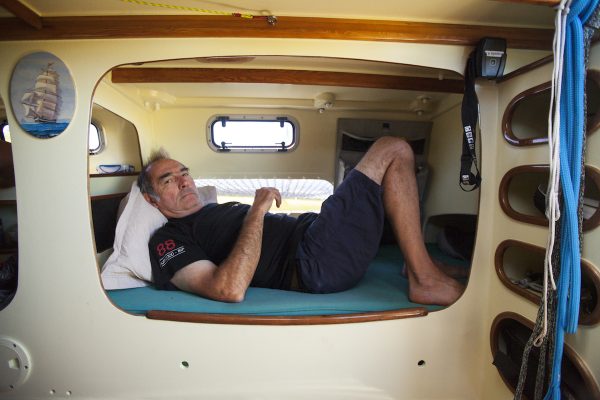
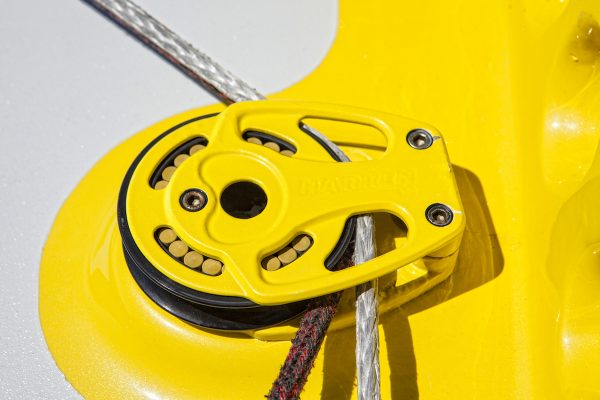
The vintage yellow livery is even used for deck hardware such as this turning block
In 1998 Capelle sailed her to 2nd place in Class 3 in the Route du Rhum. For the delivery back from Guadeloupe he left A Capella in the hands of two friends. In May the following year on the transatlantic delivery home they hit a huge storm and capsized.
“The coastguards recovered my friends but the boat was declared lost, [then found] 18 months later. She managed to complete the Atlantic crossing upside down all alone and ended up in Galicia. But the local authorities didn’t inform us. The local kids used her as a toy to play around on. It was Nigel Irens who told me where she was and what was going on.”
Capelle went to Galicia and once again set out to bring his stricken craft back under jury rig. The boat was almost immediately dismasted off Cape Finisterre and was towed back by the coastguards. There he met Jean Luc van den Heede who offered to tow him under sail all the way back to La Trinité.
“I got hold of a long line and he managed to bring me all the way. I rebuilt her completely for the second time. Then I decided to do the Route du Rhum in 2006.
“The boat went upside down near where she was previously dismasted off Cape Finisterre. There was a bug with the autopilot, and three boats capsized with the same problem. There was a Class 40 not far from me sailed by Philippe Legros, who picked me up. I left my beacon on the boat, so we could find her again.”
Four days later he was dropped off at the Azores where he immediately chartered a tuna fishing boat from Yeu Island, and ten days later they found the capsized A Capella and towed her, yet again, back to la Trinité. “They were four difficult years. I told myself it was my fault she had capsized. Even if the big names told me that happens, but I couldn’t cope with it. I rebuilt her again, but this time only partially as she had only spent ten days in the water and the mast didn’t break. I saved the engine and got her back in shape.”
The indefatigable Capelle was back on the startline of the Rhum in 2010, slightly more cautious but still as in love with the race and his boat as ever.
“It was a tough Route du Rhum for me, because I was afraid of capsizing. This time I decided to bring her home on a cargo ship!”
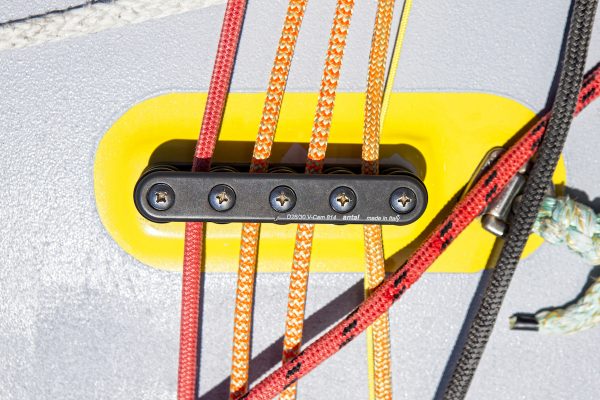

The lifting daggerboards are now carbon, as are the floats, thanks to Capelle’s expertise

The mast is set on a stainless steel ball, and can be both rotated and canted
Back in the game
In between times, the fiery yellow A Capella has done dozens of other races, the Armen Race, the Fastnet, the SNSM, and inshore series. Capelle explains: “In France for two years I was Multi 2000 champion on her. I’ll be taking part in the next Route du Rhum, the sixth for A Capella and the fifth with me.
“She’s a boat that doesn’t want to die. Each time she capsizes, she comes back again. Each time people tell me I’m crazy. But I go for it each time and rebuild her.”
Capelle competed in this year’s Rolex Fastnet Race, finishing fourth in the MOCRA multihull class. He describes the start as epic. “The exit out of the Solent was the best part of the race; straight out into a seaway. And the south coast of England was so beautiful I wanted to stop and visit.
“Downwind after the Rock was extremely hard work – this is her Achilles heel in a certain respect – as the boat is not adapted for large swell downwind in breeze. It is an extremely wet boat.” They raced three-up and all three remained on deck for the entire period from the Fastnet Rock to the arrival in Plymouth, with one on the helm and two on the sheets.
Next year’s Route du Rhum will be a rematch of the ‘Golden Oldies’, multihulls built before 1988. The trimarans have also raced each other in the Trophée SNSM, where Peyron’s Happy proved slightly faster than A Capella.
But Capelle says the result is not his main reason for competing in the 40th anniversary event: “The Rhum is an adventure for me. I try to do my best and see how I do against the others, but that is not the main goal for me. The aim is to finish and to continue the history of the Acapellas.”
SPECIFICATIONS
Length 12m (39ft 4in)
Beam 7.8m (25ft 7in)
Mast Height 16.8m (55ft 1in)
Displacement 2.5 tonnes
Build Wood/epoxy
Design Walter Greene &Nigel Irens, 1978
Additional translation by Tim Carrie.



